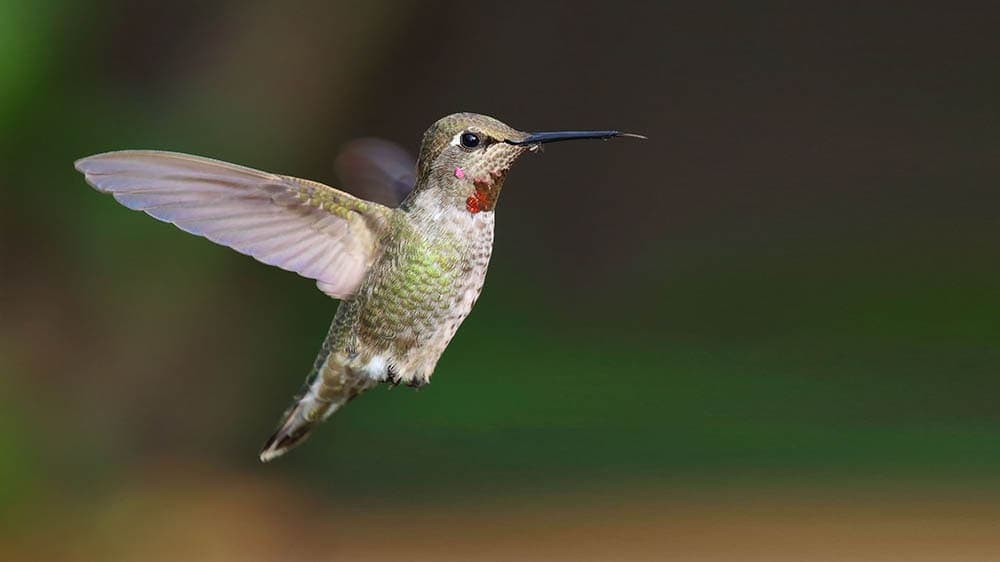Why Do Hummingbirds Hover in Your Face? 4 Reasons for This Behavior
Last Updated on

Hummingbirds are a magical sight, which is why so many people put up hummingbird feeders. It’s so interesting to watch as their wings patter a million miles an hour while their bodies stay so still. If you’ve ever been close to where hummingbirds dwell, you might see them come up to meet your eyes.
So, what exactly are they trying to tell you? Have you upset them? Are they happy to see you? While one reason is super common, there are a few things they could be trying to say. Let’s get into it.

Hovering Hummingbirds: What Are They Trying to Say?
Meeting a hummingbird face to face can be a little intimidating since they are so fast and buzz so loudly. Here’s what their up-close-and-personal greeting may be trying to communicate:
1. Curiosity
These hummingbirds might be just as intrigued in you as you are in them. If you are nearby where they’re hanging out, they might come up to inspect you. This is not an act of aggression, it is simply to learn more about this strange creature in front of them.
2. Territorial
It’s infrequent that hummingbirds would ever be aggressive toward people. However, they might be irritated with another unfamiliar bird hanging around. After all, they want all the goods for themselves. So, if you see more than one bird flying around, they might be a bit more frantic than usual and less worried about getting close to you.

3. Colors
Are you wearing bright colors when you feed your birds? Hummingbirds are very attracted to bright colors, in fact, red is a hugely popular choice for attracting them to a feeder. So, if you are wearing vibrant colors, you might be alluring to them at that moment.
4. Hunger
If you have some spoiled hummingbirds that you feed regularly, they might be giving you a friendly reminder that they need some more sweet nectar water. If they grow accustomed to you feeding them, they won’t want that to stop—so don’t be surprised if you get hassled.
Incredible Hummingbird Facts
If you love hummingbirds, or you’re just interested in these exceptional, mysterious beauties, here are some facts you might not know.
- There are over 330 species of hummingbird. They can come in all sorts of colors and patterns, but they share the same general size—with very recognizable bodily structures.
- Hummingbirds are native to the Western H All of these species live in both North and South America—from Alaska to Chili.
- Half hummingbird species live along the equator. Hummingbirds love tropical weather. Most species prefer hanging out in hot, humid weather.
- Hummingbirds are about 3.75 inches long. However, the giant hummingbird reaches a whopping 9+ inches.
- A hummingbird’s heartbeat is between 50 and 1,260 beats per minute. The giant hummingbird has the slowest heart rate, beating 10 to 15 bears per second. The amethyst wood hummingbird is the fastest, recording 80 beats per second.
- Hummingbirds’ wings beat around 80 beats per second. Their wings allow them so much mobility in the air—able to fly backward, forwards, hover, and sometimes fly upside down.

In Conclusion
So, if you see a hummingbird come up to meet your face, you can pretty much guarantee it’s a friendly hello—or they’re requesting a feeder refill. Unless the hummingbird seems agitated for another reason, they’re likely not upset or acting territorial.
Even if the hummingbird is upset, it is probably due to another hummingbird hanging around—as they don’t view humans as adversaries.
Featured Image Credit: Ercan Uc, Shutterstock
About the Author Ashley Bates
Ashley Bates is animal writer and enthusiast who is currently studying the art of animal therapy. A mother to four human children— and 23 furry and feathery kids, too – Ashley volunteers at local shelters, advocates for animal well-being, and rescues every creature she finds. Ashley's mission is to create awareness and education about animals of all shapes and sizes to promote proper care and respect.
Related Articles:
How to Clean a Refractor Telescope: Step-by-Step Guide
How to Clean a Telescope Eyepiece: Step-by-Step Guide
How to Clean a Rifle Scope: 8 Expert Tips
Monocular vs Telescope: Differences Explained (With Pictures)
What Is a Monocular Used For? 8 Common Functions
How to Clean a Telescope Mirror: 8 Expert Tips
Brightfield vs Phase Contrast Microscopy: The Differences Explained
SkyCamHD Drone Review: Pros, Cons, FAQ, & Verdict
